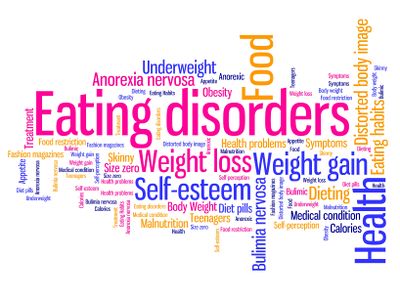In today’s society, it is not uncommon for celebrities to want to change the way they look. These stars want to feel more confident in themselves, especially when they are constantly in the spotlight for everyone. Most celebrities felt like their figures could be improved. Some understood that for their performance, they were required to resemble most similar to their character. These “diets” are dangerous because accompanying the malnutrition, these celebs also work out excessively. Thus, restrictions from food can cause alarming symptoms such as thinning hair, depression, sickness and blacking out. Please be informed that these regimes are a significant cause of eating disorders such as anorexia.
The term eating disorder applies to a combination of behavioral health problems that involve mental health and physical symptoms.
Andre Guerreiro, a Junior at Colonia High School gives his opinion on how media can also be the cause of health issues among young adults, “People are not informed that not everything on social media is necessarily real and that they don’t know it’s because of photo-shop. They’re just not informed and people need to tell them that they’re bodies don’t actually look like that.”
The Nurse
The nurse at CHS notifies the school on how this takes a toll on the body, “It has a big effect on the heart, liver, stomach- your stomach shrinks. It also harms the esophagus because you’re bringing up the acids from your stomach. It changes your menstrual cycle. You can have an early heart attack, it changes the brain too. It can also affect your life span by making it shorter. It’s not that they’re refusing to eat, it’s their mind that’s telling them that they’re heavy. “
The nurse tries to help to the best of her ability but the majority of the time it is out of her hands, “They need more than a school nurse, they need counseling. They need a dietitian to work with them, so it’s more than just me. There can be recommendations for them to talk to a counselor or the SAC counselor. But most of the time they need outside help to come up with a plan to help them eat better. These students come in a lot, maybe as much as the counselors. I have done screenings on tenth graders, and get their sports physicals; if I notice a decrease in weight then I address it to somebody. The counselor would be contacted first and I’ll leave it to them whether they want to contact a parent. I don’t wait for the student to tell me if I notice that they look gaunt or sickly. I usually tell someone when I see it.”
The Colonia nurse draws the connection that some celebrities also suffer, “A lot of times it’s the actors and actresses that also come out and say that they had an eating disorder while they were acting on a TV show, like on Full House Candace Cameron eventually came out, somebody of Growing Pain, she had an eating disorder. I think young people see this and say, “They lost a tremendous amount of weight, I can do it too.” Media has a big influence on kids. They can’t be helped until they realize they have a problem. The victim sees this photo-shop and sees “oh she’s so skinny, she looks good when in reality she doesn’t.”
Celebrities
- Demi Lovato
- Demi Lovato (27) has always been exposed to cameras and Hollywood from the very beginning. From the tender age of 12 years old, she first debuted on Barney and Friends. As a teen, Lovato often appeared in well known Disney shows and movies such as Camp Rock, Sonny With a Chance and Princess Protection Program. Stated by Health Line, “Demi Lovato has become an unofficial spokesperson for young women with eating complications since being treated for bulimia and anorexia in 2010.” Lovato revealed that she struggled with eating after her breakup in 2016 from a longtime boyfriend, Wilmer Valderrama.
- Zayn Malik
-
- Zayn Malik (26) is largely known as, “The One Who Left One Direction.” When in reality he is a humble and reserved singer as of 2016. After splitting up from the boy band at the age of 22, Malik had since then released 67 songs. Malik is not on social media often and prefers to keep his life private. In November 2016, Zayn released an autobiography and revealed that he would sometimes go for days without eating.
- “Something I’ve never talked about in public before, but which I have come to terms with since leaving the band, is that I was suffering from an eating disorder,” Malik writes in a passage acquired by The Sun. “I’d just go for days — sometimes two or three days straight — without eating anything at all. It got quite serious, although at the time I didn’t recognize it for what it was.”
- Malik stated that his eating disease reached its peak in 2014. “When I look back at images of myself I can see how ill I was,’ he wrote. “The workload and the pace of life on the road put together with the pressures and strains of everything going on within the band had badly affected my eating habits.”
- Malik also said that he didn’t want to believe that his illness was serious, “People saw strength in that, and they didn’t seem to expect it from a guy, but they expect it from a female, which to me is crazy,” Malik told Sunday Times Style. “We’re all human. People are often afraid to admit difficulties. But I don’t believe that there should be a struggle with anything that’s the truth.”
- Malik explains that mental illness and difficulties should not be brushed aside. He doesn’t believe that anyone should have to struggle alone and without help.
- Since then Malik has recovered and is healthier now but he still fights anxiety and panic attacks.
-
- Shailene Woodly for the film Adrift.
- The movie Adrift is about a couple who sail from Tahiti to San Diego. On the journey, they confront a hurricane that damages their boat and sets them afloat in the ocean. Shailene said that she wanted to most accurately portray a woman who was starving for 41 days on the sea. To achieve that appearance to the best of her ability, Woodly only ate 350 calories a day. According to People, Woodly opens up about her diet and said that “For the last two weeks I had a can of salmon, some steamed broccoli and two egg yolks every day — 350 calories,”
- The consequences of this overbearing diet are that it affected Woodly’s sleep schedule and made her prone to sickness, according to Sam Clafin, 33, he and Woodley were oftentimes seasick. “We were holding each other’s hair back,”
- The movie Adrift is about a couple who sail from Tahiti to San Diego. On the journey, they confront a hurricane that damages their boat and sets them afloat in the ocean. Shailene said that she wanted to most accurately portray a woman who was starving for 41 days on the sea. To achieve that appearance to the best of her ability, Woodly only ate 350 calories a day. According to People, Woodly opens up about her diet and said that “For the last two weeks I had a can of salmon, some steamed broccoli and two egg yolks every day — 350 calories,”
Talking with Guidance Counselors
Covering this topic, the journalism team spoke to Jacqueline Giordano, the Student Assistance Counselor at Colonia High School. Giordano’s opinion on the images celebrities portray is nonsensical and can do a lot of damage to influential young adults.
“I feel as if it’s very unrealistic because of the amount of money they spend to help them with diets, workouts and to reshape their image is unrealistic for the average citizen. It sends a message that these unrealistic goals are obtainable when sometimes, they’re just not. I think it’s bad for youth, I think it’s bad for everybody.”
She then lists some methods famous celebrities use to make themselves look better that kids may not be aware of, “Also, with all of the airbrushing of photos and things like that- it’s terrible, it’s a bad body image. It’s bad for self-esteem, and it just puts so much more pressure on about their self-image and their body. It’s not healthy. I don’t know if kids realize, because when they see a picture of a celebrity online, they’re thinking, ‘That’s what they naturally look like’ but it’s not. People really do have cellulite and do have lumps, and bumps but they get rid of it all. When kids look at themselves, they think somethings wrong with them, “why do I have this and they don’t?” So again, it’s unrealistic goals, I hate it.”
Giordano expresses that it creates pressure on young adults to achieve the unobtainable flawless body image that celebrities portray. Needless to say, these demands in society can cause serious harm to mental health and physical well being. She also admits that is it common for her to witness students battling eating troubles. “Every year I work with students with eating disorders, absolutely. Some years much worse than others, but every year. Every year I have a handful of kids that come forward about their eating disorders and want to seek help. Or someone in the building that becomes so concerned about a student that they express it to me. These are only the ones that I know about. There are plenty of kids that go undetected or under the radar… that I don’t know.”
“I definitely get teachers every year concerned about a student. Sometimes that how I get a referral. From the teachers, sometimes it’s from a parent that calls with questions. Sometimes it’s a student that comes down to know how you know if you have an eating malady. Or what to do if they need help with one that they have. Sometimes kids come down about their friends, they’re concerned about.”
Giordano assured that if a student were to tell her about someone else, everything is confidential and private. No names would be released and everything that happens between her and that student is secure. Everyone could come down to say anything like mental health issues such as anxiety, depression or alcohol and drugs. “ You want to feel comfortable that you could come to talk and it’s not going to go anywhere else.”
How to Help
Giordano then reveals the process of helping her students. “First, we talk about diets then, we talk a little bit about weight. And if there’s been a great weight loss or is it binging. What some of their behaviors are, we could see if we’re able to work on trying to change those behaviors. I usually ask kids if their parents are aware; if it’s something they would like me to contact their parents about. Sometimes we could get the nurse involved and we could do weigh-ins if that’s something we decide is important.”
Giordano expresses her concern, “Sometimes we wind up with outside counseling, treatment programs. Then, other times I could refer to self-help groups that are free. If they could get there, listen, learn a little bit. If they’re not ready to tell a parent yet they could go alone and see. It depends on the severity. Sometimes eating troubles get so bad they could affect your heart, they could affect different organs, so it all depends.”
Finally, Giordano concludes with a positive message, “Everybody goes through difficult periods in life at different times in life. It could be when they’re young, it could be when they’re young adults, it could be while they’re an adult. But the important thing is to get help if you need it because they’re treatable and manageable. You could get through it if you take care of it. If you just think it’s going to go away, it’s not going to go away. You have to learn how to deal with it, how to cope with it, the best ways to manage it. Then it’ll be easier for the rest of your life because then you’ll have more tools and techniques. To do something about it when you feel like it’s becoming a problem rather than to put it off and to hope it goes away.”
Body expectations can greatly affect a person’s mental health and physique. Celebrities go on diets to maintain their slim figures. These requirements can discourage a person’s self-esteem and cause feelings of unworthiness. Anorexia Nervosa is not the only eating sickness, two other common types are also, bulimia nervosa and Binge eating disease. The specific reason for eating ailments is unexplained. However, it is understood that it is a mixture of biological and environmental factors. There could be media influence, family influence and peer influence that aids in the development of these sicknesses.
Contact the eating disorder helpline or get in touch with an adult. Refer to this helpline for more information on recovery and symptoms.











